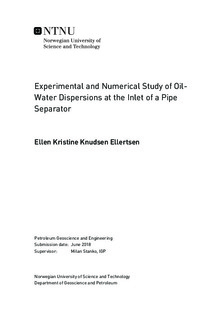Experimental and Numerical Study of Oil-Water Dispersions at the Inlet of a Pipe Separator
Abstract
In the production of petroleum, it is normal to not only produce oil and gas, butalso to produce water. Over the lifetime of the fields, the amount of water producedwill normally increase. The additional water will later have to be separatedfrom the oil and gas, either at the surface or down on the seabed. If the processingfacilities cannot handle these higher rates of water, the producing line has to bechoked back, which will result in a lower production of oil. Increasing the efficiencyof oil-water separators and develop subsea separation solutions will therefore allowto maintain, or increase the fields production rate, hence reducing cost. Theseparation performance is affected, among other things by the droplet size. Thisthesis is focused on studying the characteristics of oil-water flow and droplet sizedistribution at the inlet of an oil-water pipe separator for varying rates of oil andwater.
Experimental tests were performed at the inlet section of an inline oil-water pipeseparator developed at NTNU (SUBPRO project 2.9). Four main tasks were performed.First, measurements of the physical properties of the oil and water wereperformed. Second, the flow pattern map of the system was determined varyingthe flow rates and water cuts. Third, the droplet size distribution was computedby analyzing and processing pictures of the flow taken with a PVM probe. Theanalyzing of the images were performed manually and automatically using a computationalroutine written in Matlab. The droplet size distribution was quantifiedfor several flow rate combinations, two water cuts, two probe positions and twovalve openings. Additionally, the droplet size distribution data was compared withfour statistical distributions and models; Log-Normal Distribution, Upper-LimitLog-Normal Distribution, and different breakage models.
It was found that the flow system with the valve fully open had larger droplet sizesfor flow rates in the higher range. However, with the valve 50% open the dropletsizes got smaller for flow rates in the higher range. With more water present in thesystem the droplet size decreased. The droplet sizes for oil-in-water were smallerthan the droplet sizes for water-in-oil. The Brauner breakage model and the Upper-Limit Log-Normal Distribution gave the best representation of the data. Theexperimental data gathered has a great value for future validation of multiphaseand dispersion models, thus improving their predictability and quantifying andreducing their inaccuracies.
